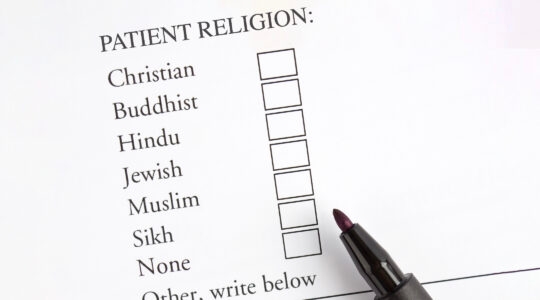In my 15 years writing this column, which has focused on the connections between culture and community, I’m not sure I’ve ever had as powerful a sense of the transformative power of Jewish ideas as in the creative arc of writer/performer Josh Kornbluth.
A San Francisco Bay Area institution and former TV talk show host, Kornbluth is a renowned writer and monologist, whose autobiographical work includes probing explorations of such inherently undramatic topics as math, taxes and the Berkeley environmental commission.
Last year I invited Kornbluth, whose one-man shows like “Benjamin Franklin: Unplugged” and “Love & Taxes” have traveled around the country, to create a performance exploring art and Jewish identity, in reaction to the exhibition “Warhol’s Jews: Ten Portraits Reconsidered,” which was about to appear at the Contemporary Jewish Museum. The exhibition, which originated at The Jewish Museum in New York, revisited the creation and meaning of portraits of famous Jews such as Einstein, Freud, Martin Buber and Golda Meir that Andy Warhol created 30 years before. Kornbluth called his show “Andy Warhol: Good for the Jews?”
The New York Times covered the sold-out, weeklong workshop production, describing how Kornbluth began pondering the themes of rejection, marginalization and ideological struggle in his own life. “‘I’d thought that because I’m not a religiously observant Jew, then I’m not a Jew,’” the Times quoted him as saying. How wrong he was.
Kornbluth’s expanded production of “Andy Warhol: Good for the Jews?” had its premiere last month at Theater J in Washington, D.C., and just began its run at The Jewish Theatre San Francisco.
What was this piece about? As represented in the show itself, at first it focused on the irrelevance and impenetrability of both Andy Warhol and serious Jewish thought. But just as Kornbluth came to the most obscure member of Warhol’s minyan — Martin Buber — it changed direction.
Through Buber’s famous formulation of the “I-Thou” spiritual relationship, Kornbluth countered the public view of Warhol as a superficial, morally bankrupt capitalist. Instead, he started to see Warhol’s icon-like portraits not as a barrier to intimacy and depth, but as a subtle invitation into a spiritual experience. Through Warhol’s Buber, Kornbluth — an avowed atheist and son of hardcore communists — began to understand more deeply the possibilities of Jewish spiritual life.
Kornbluth’s transformation suggests at least two interrelated lessons for Jewish life. The first is that a Jewish community, by making itself wholly available to a “marginal Jew,” offered a first-rate artist a moving and transformative Jewish experience.
The second is that a Jewish community struggling to promote inspiring Jewish ideas to an increasingly assimilated population saw reflected back at itself a message worth promoting.
One final lesson concerns the deep connections between art and community. In my conversations with Kornbluth it became clear that his creative process — he writes not by himself, alone in a room, but by improvising in public — is the very essence of the I-thou relationship. For a Jewish community struggling to have a true dialogue with itself over the meaning of Israel, kashrut, financial responsibility and even God, Kornbluth’s high-wire act of writing this piece in public reminds us of the need to engage each other truly and deeply, and to take risks.
At the end of his monologue, Kornbluth acknowledged that at age 50 he entered a synagogue for the first time. Hearing the rabbi talk about a God that could be described as “the sum total of the collective imagination and hope of humanity” created a paradigm shift in his brain. “That,” he said in the show, “is a God I could get behind.”
I guess I’ll “out” Kornbluth a little further, and reveal that after his synagogue visit he came to our house for his first Passover seder. My son, immersed in Yiddishkeit, and his, at the beginning of his family’s exploration, took pictures of each other’s hands as part of an online Torah project.
I’m not expecting Kornbluth’s new play to be called “My Year in Borough Park.” But to see our kids talking Torah at the Passover seder … that was good for the Jews.
Daniel Schifrin is writer-in-residence and director of public programs at the Contemporary Jewish Museum in San Francisco.
|
Signup for our weekly email newsletter here. Check out the Jewish Week’s Facebook page and become a fan! And follow the Jewish Week on Twitter: start here. |
The New York Jewish Week brings you the stories behind the headlines, keeping you connected to Jewish life in New York. Help sustain the reporting you trust by donating today.




